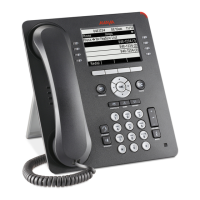Other network considerations
Issue 3 January 2014 27
parameter. For more information, see Chapter 5: Administering DHCP and HTTP servers.
Note:
Note: SNMP is disabled by default. Administrators must initiate SNMP by setting the
SNMPADD and SNMPSTRING parameters appropriately.
For more information about SNMP and MIBs, see the IETF Web site
www.ietf.org. The Avaya
Custom MIB for the 9600 Series SIP IP Telephones is available for download in *.txt format on
the Avaya support Web site at
www.avaya.com/support.
Note:
Note: The SIP software release 2.6 MIB is different than that of release 6.3.1 MIB.
Ensure to download the MIBs applicable to your environment.
Registration and authentication
9600 Series IP Deskphones require an outboard proxy SIP (OPS) extension on
Communication Manager and a login and password on the Session Manager server to register
and authenticate.
Note:
Note: For the SIP Deskphones to work properly, you must specify the correct domain
name in the IP Network Region screen of Communication Manager. For more
information on the IP Network Region screen, see Administering Network
Connectivity on Avaya Aura® Communication Manager (555-233-504), Issue 16,
May 2011, available at
www.avaya.com/support
For more information on the registration process, see Maintaining and Troubleshooting Avaya
Aura
®
Session Manager (03-603325), available on the Avaya support Web site, http://
www.avaya.com/support and your call server administration manual.
Ping and traceroute
All 9600 Series SIP IP Telephones respond to a ping or traceroute message sent from the call
server switch or any other network source. For more information, see your call server
administration documentation.
IP address and settings reuse
After a successful registration with a call server, the IP address of the deskphone and the
parameter values are saved in the non-volatile memory of the deskphone. The deskphone can
reuse the saved parameters if the DHCP or HTTP/HTTPS server is not available for any reason
after the deskphone restarts.

